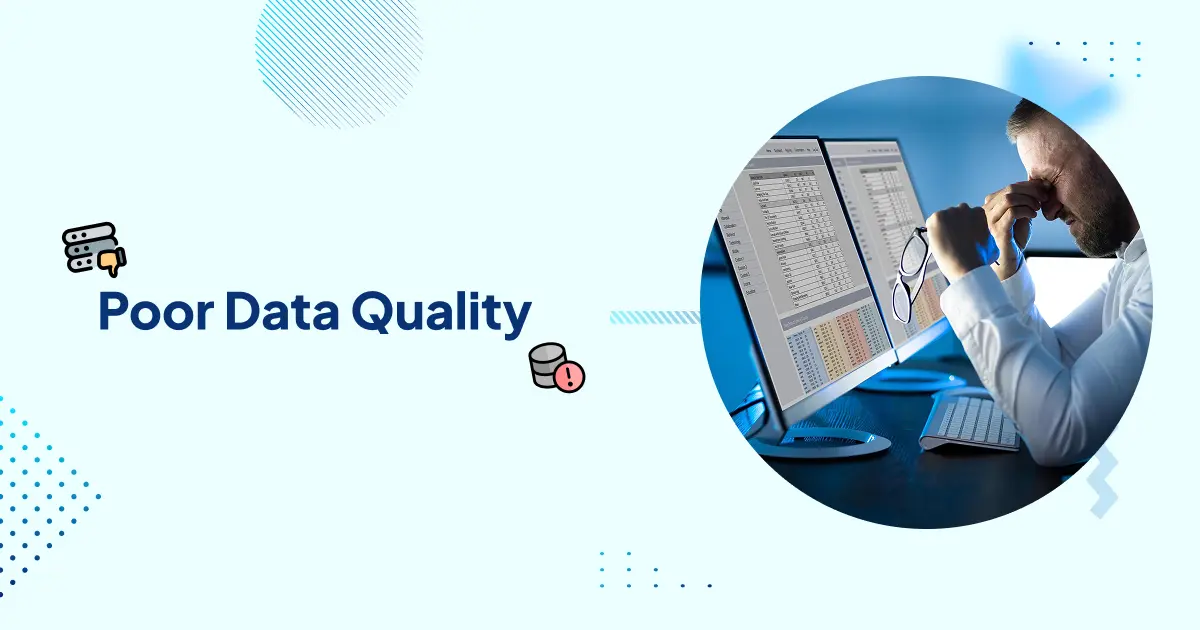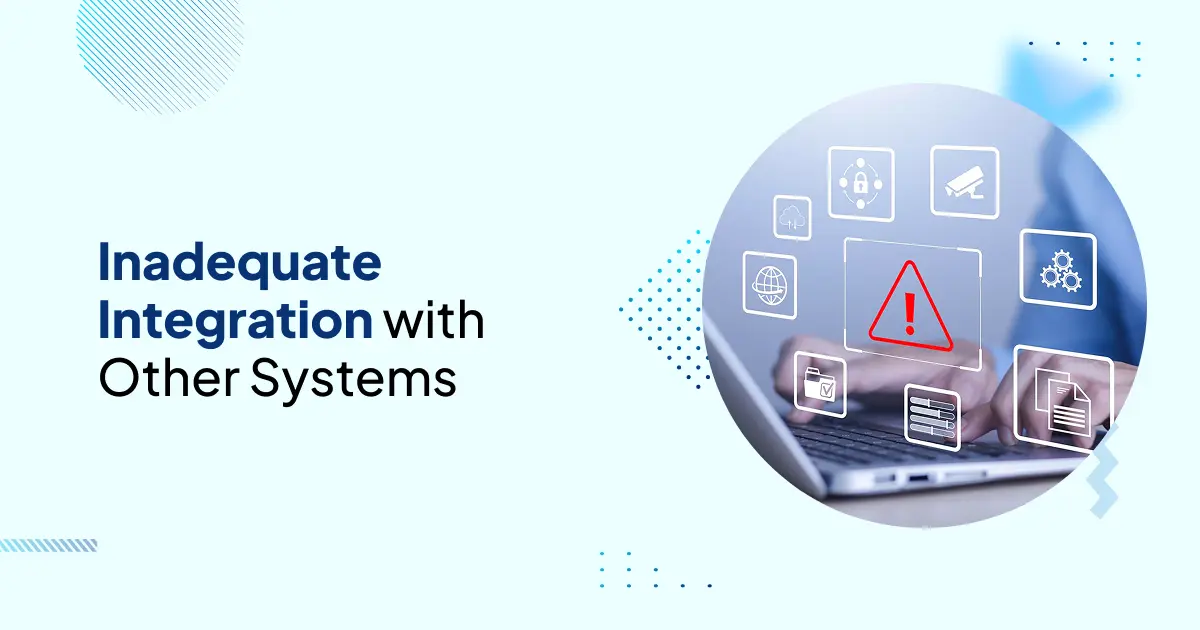
CRM Integration
October 14, 2025
Rabial Saqib
5 CRM Integration Mistakes That Undermine Your ROI
Implementing a CRM system promises better customer management and improved business results. However, despite the benefits CRM systems offer, many organizations experience poor returns due to avoidable integration mistakes.
The CRM Integration Challenge
These errors can cause inefficiencies, user frustration, and wasted resources that reduce your return on investment (ROI). This article highlights five frequent CRM integration mistakes and explains why they undermine ROI. Furthermore, it outlines practical steps to help you avoid these pitfalls.
By addressing these challenges head-on, you position your business for a successful CRM integration that drives lasting growth.
Lack of Clear Objectives
High impact on success
Poor Data Quality
High impact on accuracy
Insufficient Employee Involvement
Critical for adoption
Inadequate System Integration
Medium impact but common
No Focus on Future Needs
High impact on scalability
CRM Integration Impact on ROI
This chart shows how different CRM integration mistakes impact your return on investment. Data quality issues and lack of clear objectives have the most significant negative effects.
Employee Adoption Rates by Department
This chart demonstrates how different departments adopt CRM systems. Sales teams typically show the highest adoption rates when properly trained and involved in the selection process.
Table of Contents
CRM Integration Impact Comparison
| CRM Integration Mistake | Impact on ROI | Difficulty to Fix | Priority Level |
|---|---|---|---|
| Lack of Clear Objectives | High | Medium | High |
| Poor Data Quality | Very High | High | Critical |
| Insufficient Employee Involvement | High | Medium | High |
| Inadequate System Integration | Medium | High | Medium |
| No Focus on Future Needs | High | High | High |
CRM Implementation Progress
Data Quality Impact
Clean data directly impacts CRM effectiveness and user adoption rates.
Cost of CRM Mistakes
CRM integration mistakes can significantly increase implementation costs.
User Satisfaction
Employee involvement directly correlates with CRM satisfaction rates.
CRM Integration FAQs
Most CRM integrations take 3-6 months from planning to full implementation. The timeline depends on factors like data complexity, system customization, and employee training requirements. Complex integrations with multiple systems can take longer.
Poor data quality is the most common reason for CRM integration failure. Migrating incomplete, outdated, or duplicate information compromises the system’s effectiveness and leads to poor user adoption and decision-making.
Involve employees early in the selection and customization process, provide role-specific training, and demonstrate how the CRM makes their jobs easier. Leadership support and ongoing feedback mechanisms also significantly improve adoption rates.
1. CRM Integration Mistakes: Lack of Clear Objectives and Strategy

Without clear objectives, CRM implementations often fail to deliver expected results
Why It Hurts ROI
Starting a CRM integration without detailed goals often undermines the entire initiative. Many teams implement a CRM hoping technology alone improves performance; however, without a solid plan, results often fall short. As a result, efforts become scattered, and outcomes fail to meet expectations.
When an organization fails to define specific objectives, measuring progress becomes difficult. For instance, adding features that don’t align with business needs leads to wasted resources. To avoid this, establish measurable outcomes before starting the project. In addition, involve leadership and end-users early to ensure the CRM aligns with core strategic priorities.
Without measurable objectives, teams cannot track progress or prioritize features that directly impact your business. This leads to wasted time and funds on tools that don’t serve your core needs. Moreover, lack of direction can cause confusion among staff, lowering adoption.
How to Avoid It
- To begin, define clear objectives such as increasing customer retention, shortening sales cycles, or improving support response times.
- Next, involve leadership along with sales, marketing, and support teams to align the CRM with business goals.
- Finally, set measurable KPIs and review them regularly to stay on track and make necessary adjustments.
Example: A B2B manufacturing firm launched a CRM with no defined success metrics. Sales teams struggled with lead tracking, and management lacked visibility. After revising goals and involving end users, they boosted sales conversions by 12% within six months.
For further details on setting effective CRM goals, visit CRM integration objectives.
If you need help aligning your strategy with execution, explore Devtrios’ custom software development services to create tailored CRM solutions.
2. CRM Integration Mistakes: Poor Data Quality

Data quality issues can severely impact CRM effectiveness and ROI
Why It Hurts ROI
Accurate data is the backbone of an effective CRM. Migrating incomplete, outdated, or duplicate information compromises the system’s power and leads to poor decisions. Furthermore, data quality issues compound quickly if left unchecked.
Your CRM only performs well if it contains accurate and complete data. Migrating outdated, duplicate, or incomplete data remains one of the most common CRM integration mistakes. Without ongoing attention to data health, problems escalate quickly.
For instance, duplicate customer records cause confusion, slow down workflows, and reduce overall efficiency. Moreover, inaccurate or outdated data erodes customer trust and leads to misleading reports that affect decision-making.
How to Avoid It
- To ensure reliable system performance, prioritize a comprehensive data audit before migration to identify duplicates, inconsistencies, and outdated records.
- Use cleansing tools to remove errors and establish standardized data entry procedures.
- Encourage ongoing data maintenance and regular reviews.
- Additionally, promote cross-team accountability for data quality, which strengthens trust across the organization.
Example: A retail chain migrated legacy CRM data without cleaning duplicates. Consequently, sales reps wasted time contacting the same customer multiple times, lowering efficiency. A subsequent cleanup process increased outreach quality and raised response rates by 18%.
Review best practices at CRM data quality management.
Keep your CRM data accurate and healthy by leveraging ongoing support like Devtrios’ app maintenance and support services.
3. CRM Integration Mistakes: Insufficient Employee Involvement

Employee engagement is critical for successful CRM adoption
Why It Hurts ROI
Employee engagement is essential to CRM success. Many implementations fail because users are not involved early or do not receive adequate training to use the system effectively. In many cases, teams roll out CRM tools without input from the employees who will rely on them daily.
Moreover, excluding key departments such as customer support or operations often results in low adoption rates, inconsistent data entry, and limited business impact.
If staff members do not see the CRM as useful, they will avoid using it or enter incomplete data, reducing the system’s value. This causes fragmented customer information and lost productivity. As a result, opportunities for upselling or cross-selling may be missed.
How to Avoid It
- To ensure proper system alignment, involve representatives from sales, marketing, support, and other frontline roles during the selection, configuration, and testing phases.
- Their input helps tailor the system to real-world needs.
- Additionally, provide role-specific training and ongoing support to build user confidence and reduce friction.
- By reinforcing consistent usage through team feedback and leadership support, you help create a culture where CRM becomes a central part of daily operations, not an afterthought.
Example: For example, a SaaS company deployed a CRM for sales but neglected support teams. Without proper involvement, support staff avoided the system, leading to incomplete customer service records. After revised training, usage improved and customer satisfaction rose.
Learn more about employee involvement at CRM employee engagement.
Improve CRM usability with Devtrios’ UI/UX design services.
4. CRM Integration Mistakes: Inadequate Integration with Other Systems

Proper system integration is essential for CRM efficiency
Why It Hurts ROI
When a CRM fails to integrate with other business software, it creates inefficiencies and increases the risk of errors. Consequently, this lack of connection results in duplicated work, fragmented processes, and incomplete customer views.
Disconnected systems force manual data entry and increase errors. If marketing automation and CRM systems fail to sync, campaigns often rely on outdated customer data. This reduces targeting accuracy, lowers engagement, and wastes budget. Moreover, teams spend unnecessary time reconciling records across platforms.
How to Avoid It
- To ensure a smooth and effective implementation, carefully map data flows between the CRM and all essential business systems including ERP, marketing platforms, and customer service software prior to integration.
- This step helps identify potential gaps, reduce manual work, and ensure accurate data exchange across departments.
- Use APIs or middleware to achieve real-time synchronization.
- Additionally, test integrations regularly and involve IT staff in planning for ongoing adjustments.
Example: An e-commerce company’s CRM wasn’t properly linked to inventory management. Sales reps sold out-of-stock items, leading to cancellations and lost trust. Fixing integration boosted order accuracy by 25%.
Explore integration best practices at CRM system integration.
Learn about avoiding automation pitfalls at marketing automation mistakes.
For professional help, check Devtrios’ web development and cloud services.
5. CRM Integration Mistakes: No Focus on Future Needs
Why It Hurts ROI
Selecting a CRM that only addresses current needs limits your ability to grow and adapt. Ignoring scalability can lead to costly system replacements. Moreover, future changes in market demands or organizational size may expose limitations you did not expect.
Rigid systems cannot keep up with increased data volumes or process complexity. Businesses must spend significant funds to replace or upgrade, disrupting operations. In addition, limited customization restricts your ability to innovate over time.
How to Avoid It
- Choose scalable, customizable CRM platforms that adapt as your business evolves.
- Consider emerging technologies like AI and blockchain for future enhancements.
- Set periodic review points to assess new business needs and system capabilities.
- Thus, you can proactively plan for upgrades rather than reacting after problems arise.
Example: A healthcare provider purchased a CRM tailored to current patient loads. Rapid growth exposed system limits, forcing costly migration within two years. A future-ready choice could have avoided this challenge entirely.
Understand scalability importance at scalable CRM solutions.
Devtrios offers future-proof technologies like artificial intelligence and blockchain development.
Additional CRM Integration Resources
Building ROI-Driven CRM Integrations
Avoiding these common CRM integration mistakes is critical to maximizing your CRM’s ROI. Effective CRM projects combine clear goals, high-quality data, engaged users, seamless integrations, and scalability. Furthermore, successful organizations create feedback cycles to refine their processes as their needs evolve.
Key Actions
Why Devtrios?
Devtrios partners with businesses to deliver CRM solutions that align with strategic goals. Our expertise covers custom development, seamless integration, continuous support, and digital marketing to make your CRM work effectively.
Custom Software Development
Tailored CRM solutions designed to meet your specific business requirements and workflows.
Learn MoreSEO and Digital Marketing
Maximize your CRM’s potential with integrated digital marketing strategies.
Learn MoreMobile App Development
Extend your CRM capabilities with custom mobile applications for on-the-go access.
Learn MoreReady to improve your CRM ROI?
Visit Devtrios Contact to discuss your unique challenges.
Contact Devtrios Now
